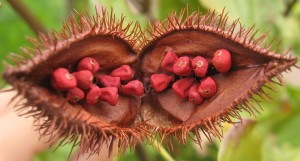Annato-turmeric color is an orange-red condiment and food coloring derived from the seeds of the achiote tree (Bixa orellana).
Contents
Uses
It is often used to impart a yellow or orange color to foods, but sometimes also for its flavor and aroma. Its scent is described as “slightly peppery with a hint of nutmeg” and flavor as “slightly nutty, sweet and peppery”.
The color of annatto comes from various carotenoid pigments, mainly bixin and norbixin, found in the reddish waxy coating of the seeds. The condiment is typically prepared by grinding the seeds to a powder or paste. Similar effects can be obtained by extracting some of the color and flavor principles from the seeds with hot water, oil, or lard, which are then added to the food.
Annatto and its extracts are now widely used in an artisanal or industrial scale as a coloring agent in many processed food products, such as cheeses, dairy spreads, butter and margarine, custards, cakesand other baked goods, potatoes, snack foods, breakfast cereals, smoked fish, sausages, and more. In these uses, annatto is a natural alternative to synthetic food coloring compounds, but it has been linked to cases of food-related allergies.
Cautions
Annatto condiments and colorants are safe for most people when used in food amounts, but they may cause allergic reactions in those who are sensitive. In one 1978 study of 61 patients suffering from chronic hives or angioedema, 56 patients were orally provoked by annatto extract during an elimination diet. A challenge was performed with a dose equivalent to the amount used in 25 grams (0.88 oz) of butter. Twenty-six percent of the patients reacted to this color four hours after intake, worse than amaranth (9%) or synthetic dyes such as tartrazine (11%), Sunset Yellow FCF(17%), Food Red 17 (16%), Ponceau 4R (15%), erythrosine (12%) and Brilliant Blue FCF (14%).
However, annatto is not among the “Big Eight” allergens (cow’s milk, egg, peanuts, tree nuts, fish, shellfish, soy, and wheat), which are responsible for more than 90% of allergic food reactions. The Food and Drug Administration and experts at the Food Allergy Research and Resource Program (FARRP) at the University of Nebraska do not consider annatto to be one of the major food allergens
Interactions
None are recorded.
Other names
n/a
References
Source: Wikipedia, https://en.wikipedia.org/wiki/Annatto

